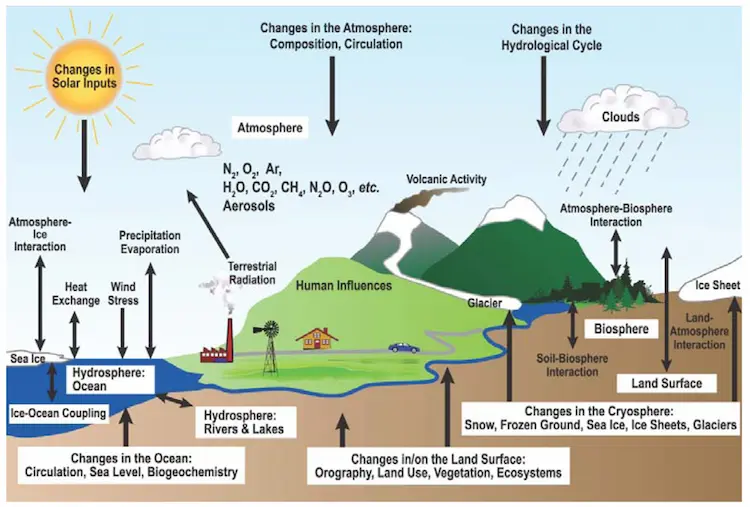In recent decades, climate change has emerged as one of the most pressing global sustainability challenges. Achieving Sustainable Development Goal 13 (SDG 13) requires addressing the drivers of ecological imbalance while maintaining the natural cycles that support life. Among the most critical yet overlooked factors are the Stoichiometric Ratios between carbon (C), nitrogen (N), and phosphorus (P), the foundation of biogeochemical cycles. Human activities such as industrial emissions, fossil fuel combustion, and intensive agriculture have severely altered these ratios, destabilizing soils, accelerating greenhouse gas emissions, and weakening ecosystem resilience. Understanding and restoring stoichiometric balance is essential for ensuring that climate action is both scientifically grounded and ecologically effective.
Macroecology and Stoichiometric Ratios of C:N:P
Stoichiometry is the study of the chemical composition of organisms and ecosystems, focusing on the relationship between key biogeochemical elements like carbon (C), nitrogen (N), and phosphorus (P). These elements are fundamental to life on Earth as they constitute the basic components of organic molecules, and their balance is crucial for the maintenance of ecosystem functionality.
The C:N:P ratios directly affect processes such as photosynthesis, decomposition, and the carbon, nitrogen, and phosphorus cycles. Research has shown that the “Redfield ratio” (106:16:1 for C:N:P) originally defined in marine systems often serves as a reference point, but terrestrial ecosystems and soils frequently deviate from it. For instance, soil organic matter tends to show much higher C:N ratios , reflecting differences in microbial activity, plant litter quality, and decomposition dynamics. Such variations influence nutrient cycling, plant productivity, and the resilience of ecosystems under climate stress.
An excess of carbon relative to nitrogen can slow decomposition, locking organic matter in soils but limiting nutrient availability for plants. Conversely, high nitrogen availability, often driven by agricultural fertilizers and industrial emissions, can accelerate decomposition but lead to phosphorus limitation. This imbalance can cause soil nutrient depletion, reduced biodiversity, and altered ecosystem trajectories over time.

Stoichiometric Ratios and Climate Interactions
Disruptions in stoichiometric ratios are not just localized ecological phenomena; they have profound global implications. For example, excessive nitrogen deposition from industrial and agricultural activities has reshaped the nitrogen cycle, leading to soil acidification, groundwater contamination, and eutrophication of aquatic systems. These processes reduce biodiversity, impair water quality, and release nitrous oxide (N₂O), a greenhouse gas nearly 300 times more potent than carbon dioxide.
Carbon-nitrogen-phosphorus imbalances also alter the ability of ecosystems to act as carbon sinks. When phosphorus is limited, even nitrogen-enriched ecosystems cannot increase plant biomass efficiently, resulting in a reduced capacity to absorb atmospheric CO₂. This creates a dangerous feedback loop: higher CO₂ concentrations lead to global warming, which further alters nutrient cycles by accelerating decomposition rates, changing microbial activity, and increasing nutrient runoff.
Emerging research highlights that soil C:N:P ratios can serve as sensitive indicators of ecological stress under climate change scenarios. For example, warming-induced shifts in microbial metabolism can lower soil C:N ratios, intensifying nitrogen mineralization and greenhouse gas emissions. Such feedback mechanisms underline why stoichiometric monitoring must be included in climate adaptation policies.
Nature-based solutions and ecosystem services
One of the most promising pathways for restoring stoichiometric balance and mitigating climate risks is the application of nature-based solutions (NbS). These approaches use ecosystems themselves, forests, wetlands, grasslands, and agricultural soils, to buffer against environmental change. Restoring wetlands, for instance, helps re-establish natural nutrient filters, reducing nitrogen runoff and improving water quality. Forest restoration increases carbon sequestration while also stabilizing C:N:P ratios in soils and vegetation.
Sustainable agricultural practices, such as crop rotation, precision fertilization, and organic amendments, can help realign stoichiometric balances. Incorporating legumes, for example, increases biological nitrogen fixation without excess fertilizer, while biochar amendments can stabilize carbon in soils. These strategies not only reduce greenhouse gas emissions but also strengthen ecosystem services such as water purification, land stabilization, and biodiversity support.
Importantly, ecosystem services tied to balanced stoichiometry have cascading socio-economic benefits. Healthier soils increase agricultural yields, cleaner waters reduce treatment costs, and stable carbon sinks lower the costs of climate adaptation. Thus, stoichiometric balance is not only a scientific concern but also an economic and social imperative.
Challenges of implementation and perspectives
Despite growing evidence of the importance of C:N:P stoichiometry, its application in global climate strategies remains limited. Policymaking often focuses on carbon emissions in isolation, neglecting the interconnectedness of nitrogen and phosphorus cycles. This siloed approach risks generating ineffective or even counterproductive solutions. For example, large-scale afforestation projects may fail to deliver expected carbon sequestration benefits if nutrient limitations are ignored.
Looking forward, achieving SDG 13 and related sustainability goals requires integrating stoichiometric principles into climate strategies at all scales, from local agricultural practices to international climate agreements:
- Integrate Stoichiometric Indicators. Embed C:N:P ratios in EU frameworks, Natura 2000, and CAP eco-schemes to guide ecosystem health monitoring and incentivize nutrient-balanced management.
- Pilot Regions and Demonstrations. Fund regionally representative projects to test mixed plantings, soil amendments, and reduced-input agriculture, demonstrating SOC accumulation and nutrient rebalancing.
- Reform Agricultural Practices. Promote precision nutrient management, cover cropping, legumes, and organic amendments to optimize C:N:P ratios and enhance soil health.
- Phosphorus-Focused Interventions. Identify P-limited areas and apply microbial inoculants, targeted fertilization, and circular phosphorus recovery to improve plant-available P.
- Monitoring and Early-Warning Systems. Establish standardized soil stoichiometry monitoring, link with remote sensing, and create indicators for adaptive management.
- Finance and Incentives. Tie EU funding to C:N:P improvements, reward long-term nutrient stewardship, and support public–private nutrient recovery initiatives.
- Research and Capacity Building. Invest in interdisciplinary research, affordable soil testing, and breeding programs that promote favorable stoichiometric outcomes.
- Governance and Stakeholder Engagement. Form a Stoichiometry Advisory Group, involve local communities, and integrate nutrient balance into climate adaptation and land-use planning. .
- Practical Restoration Measures. Use mixed-species plantings, protect topsoil, and apply targeted inoculants to rebuild SOC, TN, and nutrient availability efficiently.
- Metrics and Evaluation. Track SOC, TN, TP, C:N:P ratios, biomass, and GHG fluxes, alongside socio-economic outcomes, with regular reporting to evaluate success.
In sum, the balance of carbon, nitrogen, and phosphorus is a hidden yet powerful driver of ecological resilience and climate stability. Recognizing and restoring this balance through nature-based solutions and sustainable governance will be critical for creating adaptive, productive, and resilient ecosystems in the face of accelerating climate change.
For European policy, integrating Stoichiometric Ratios into ecological and climate strategies can strengthen biodiversity and climate resilience. Policymakers who monitor and manage C:N:P ratios in soils, forests, and water systems can better predict how ecosystems respond to farming, emissions, and climate stress. This approach allows smarter fertilizer regulation, supports soil recovery, and boosts carbon storage and water quality. Embedding stoichiometric indicators into agri-environmental programs, urban greening, and nature-based solutions reinforces the European Green Deal. Such actions cut greenhouse gases, limit eutrophication, and build healthy, resilient ecosystems that protect food, water, and biodiversity across Europe.
Read more about the sustainable lexicon here.


